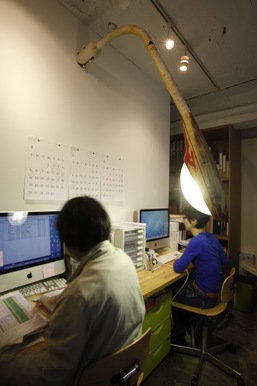Monuments Reborn in Curious Spaces
Nishi has been living in Germany since 1987 and now practices mainly in Europe, executing large-scale projects around the world that focus on the notion of public space. His representative works construct living room-like spaces that enclose everyday public objects such as town monuments and street lamps. By transforming public structures into private spaces, Nishi demolishes the notion of the everyday and provokes an intense frisson of excitement in the viewer.
TAB visited Nishi at ARATANIURANO just before the opening of his exhibition “What if someone finds out?!” to find out more about his latest work.
What about the works for this show at ARATANIURANO? Could you tell me a bit more about the scaffold-like work hanging from the ceiling?
I made this fluorescent lamp piece by taking a light fixture that was fixed to the ceiling and lowering it about one meter, and then suspending it in mid-air. The idea behind it was to present a marginal object in a new light, or revealing another side of it, by making it the center of attention. This is a concept that I’ve tried to incorporate into much of my work.
I’ve had this idea for a while now, but the conditions happened to be ideal this time around – the size of the ceiling light in relation to the small space of the gallery, in particular.


To me, it feels like the instant in which everything starts to crumble and collapse during an earthquake. Did you make the wooden supports by yourself?
I had three of my friends help me with that, but I left the wiring and other electrical considerations to a contractor. It would probably have been pretty dangerous if an amateur like myself had tried fiddling with that…
One photograph [above] looks like a kind of fountain.
It’s a Buddhist sculpture that I made out of tofu, with a halo of soy sauce around it.
Which is on a completely different scale to your previous installations. A kind of tiny, personal monument situated in the private space of someone’s home.
That’s true. As if I’d created a little monument by myself. Normally I just use existing monuments scattered throughout the city. Maybe I got inspired to create one on my own.
The actual scale of this fountain might be small if you compare it to my other work, but I’m actually really fond of this piece. I think it has an impact that rivals the grander projects [I’ve also done] that required a lot of money to pull off. I was trying to make a miniature version of a sort of gokurakujoudo (Buddhist promised land). I think a good artist is someone who is able to make excellent work regardless of his production budget. It may look cheap, but I’m satisfied.
Read part two of our interview with Tatzu Nishi here.
Darryl Jingwen Wee
Darryl Jingwen Wee



